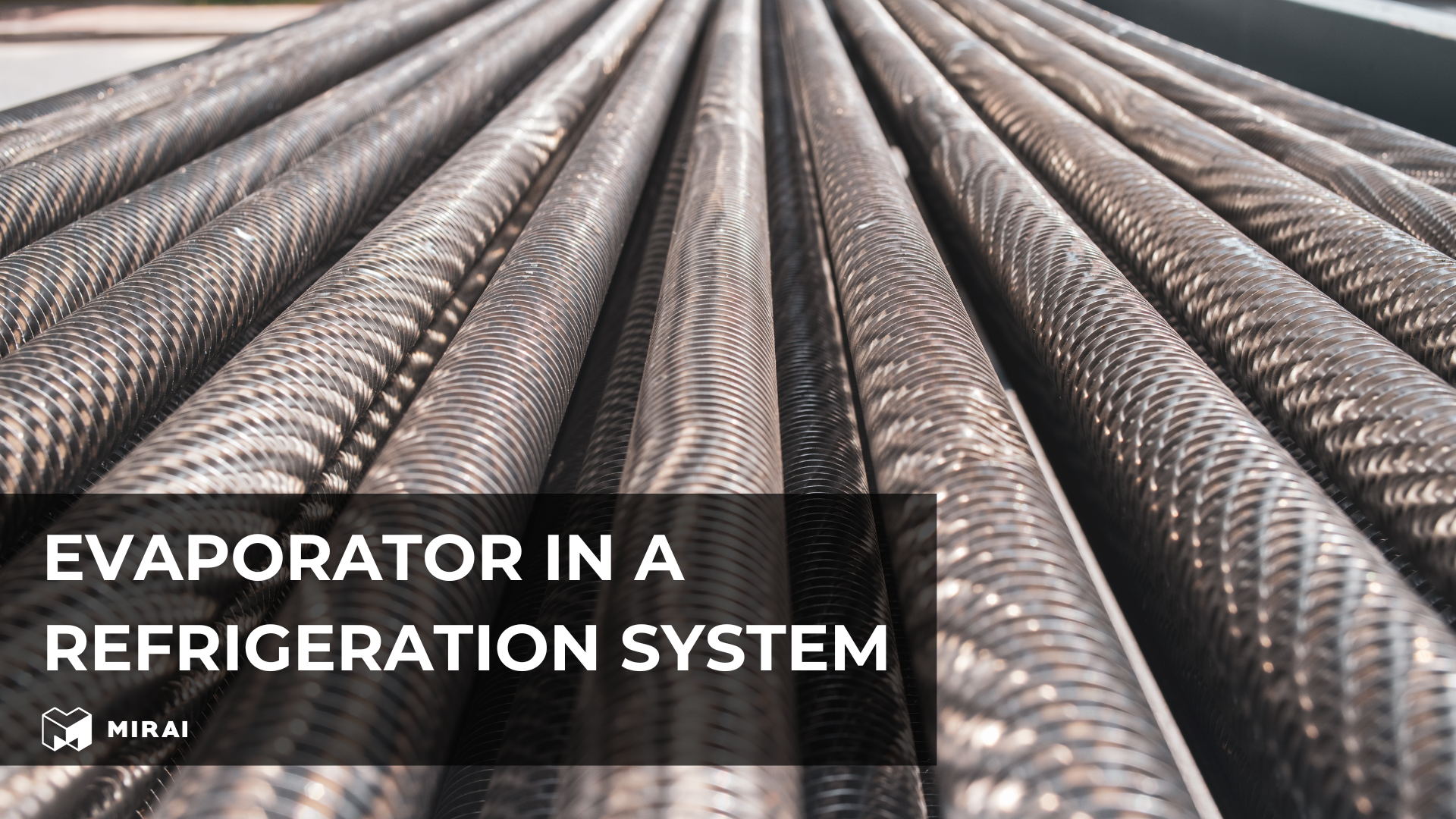The evaporator in a refrigeration system

The evaporator in a refrigeration system is a fundamental component of any refrigeration or air conditioning system, playing a crucial role in the process of cooling air or substances. But what does an evaporator do?
Its primary function is to extract heat from the environment or specific enclosed spaces, contributing significantly to the cooling cycle. This article explores the role, functions, types, and future developments of evaporator technology in refrigeration systems.
Role of the Evaporator in the Refrigeration System
In any refrigeration or air conditioning system, the evaporator serves as the component where the actual cooling effect takes place. It is here that the refrigerant absorbs heat, fulfilling the system’s primary purpose of cooling the enclosed environment. The evaporator functions by allowing the refrigerant to evaporate and expand in a controlled environment. As the liquid refrigerant enters the evaporator, it encounters low pressure, which causes it to vaporize and absorb heat from the surrounding air or medium that needs cooling. This heat absorption process effectively removes warmth from the air, thereby lowering the temperature inside the refrigerated space or conditioned area.
Understanding how an evaporator works is key to appreciating its significance in the refrigeration cycle, which also includes the condenser, compressor, and expansion valve. These components work in a continuous loop to transport the refrigerant through various states of pressure and temperature, enabling efficient heat exchange and temperature control. The compressor pumps the refrigerant, now a warm vapor, out of the evaporator and into the condenser where it releases the absorbed heat and reverts to a liquid. The cycle repeats, maintaining a consistent cooling effect. By understanding each component's role and the principles of thermodynamics applied, one can better diagnose issues, improve efficiency, and extend the system’s lifespan.
Functions of the Evaporator
Functions of evaporator in refrigeration system are heat absorption and conversion of liquid refrigerant into gaseous refrigerant
Heat Absorption
The primary function of the evaporator in the refrigeration system is heat absorption. It removes heat from the inside of a refrigerator or a conditioned space, thereby lowering the temperature. The efficiency of this heat transfer process is crucial for the overall performance of the refrigeration cycle.
Conversion of Liquid Refrigerant into Gaseous Refrigerant
As the cold liquid refrigerant passes through the evaporator coil, it absorbs heat from the warmer air inside the refrigerator or the room, leading to its vaporization. This conversion from a liquid to a gaseous state is essential to maintaining the refrigeration cycle, facilitating the continuous flow and exchange of thermal energy.
Temperature Reduction
The ultimate purpose of the evaporator is to reduce the temperature of the air in the surrounding environment. By absorbing heat and causing the vaporization of the refrigerant, it cools down the air, achieving the desired temperature control in refrigeration and air conditioning systems.
Types of Evaporators
There are several types of evaporators, each designed to suit different system requirements and operational efficiencies:
- Static Evaporators. These are used in applications where there is little to no air movement naturally, and the refrigerant flows naturally without forced circulation. Static evaporators are often found in smaller cooling systems or where minimal maintenance is desired. They rely on the natural convection currents of the air around them to facilitate the heat exchange process.
- Film Evaporators. In these systems, a thin film of refrigerant is spread over the heat exchange surface to enhance heat transfer and efficiency. This method allows for rapid heat exchange and is typically used in chemical processing and dairy operations. Film evaporators are appreciated for their ability to handle viscous fluids or those containing solid particles.
- Flooded Evaporators. These involve the evaporator being flooded with refrigerant, providing excellent heat transfer capabilities for large-scale industrial applications. They are particularly effective in systems where constant cooling is required, as they maintain a high refrigerant charge and utilize a pump to circulate the refrigerant.
- Diffusion Evaporators. Typically used in situations where both absorption and diffusion are needed to facilitate the refrigeration process. These are less common and are used in specialized applications such as in certain types of refrigerators and air conditioning units where a mixture of gas and liquid phases enhances the cooling effect.
- Each type of evaporator has its own unique benefits and challenges, making them suitable for specific applications based on the nature of the environment and the cooling demands of the system. Understanding these differences is crucial for selecting the right evaporator type to achieve optimal performance and efficiency in any given installation.
Effect of Evaporator on Energy Efficiency of Refrigeration System
The design and functionality of the evaporator directly impact the energy efficiency of a refrigeration system. A well-designed evaporator maximizes heat transfer while minimizing the required energy input, leading to reduced operational costs and enhanced system performance. The efficiency of an evaporator is determined by its ability to maintain optimal temperature and pressure conditions that facilitate the rapid vaporization of the refrigerant while ensuring minimal energy consumption.
Evaporator in Mirai Intex machines
Mirai Intex's unique cooling system uses air, which is in a gaseous state, as a refrigerant and does not use an evaporator in its machines. In case of closed cycle machines, there is a HEX (Heat Exchanger) which is used to transfer HTF (Heat Transfer Fluid).
Future Development of Evaporator Technology
The future development of evaporator technology focuses on improving heat transfer efficiency and reducing the environmental impact of refrigeration systems. Innovations in materials and design, such as nano-coatings and microchannel technology, aim to enhance the evaporative process while reducing the footprint of refrigerants with high global warming potentials. Additionally, advancements in smart monitoring systems and automated controls are expected to optimize the performance and energy consumption of evaporators further.
In conclusion, the evaporator is an indispensable component of the refrigeration cycle, responsible for the actual cooling by absorbing heat and facilitating the vaporization of the refrigerant. Its efficiency significantly affects the overall performance and energy consumption of refrigeration and air conditioning systems. With continuous technological advancements, the future of evaporator technology looks promising, with a focus on sustainability, efficiency, and enhanced cooling performance.

